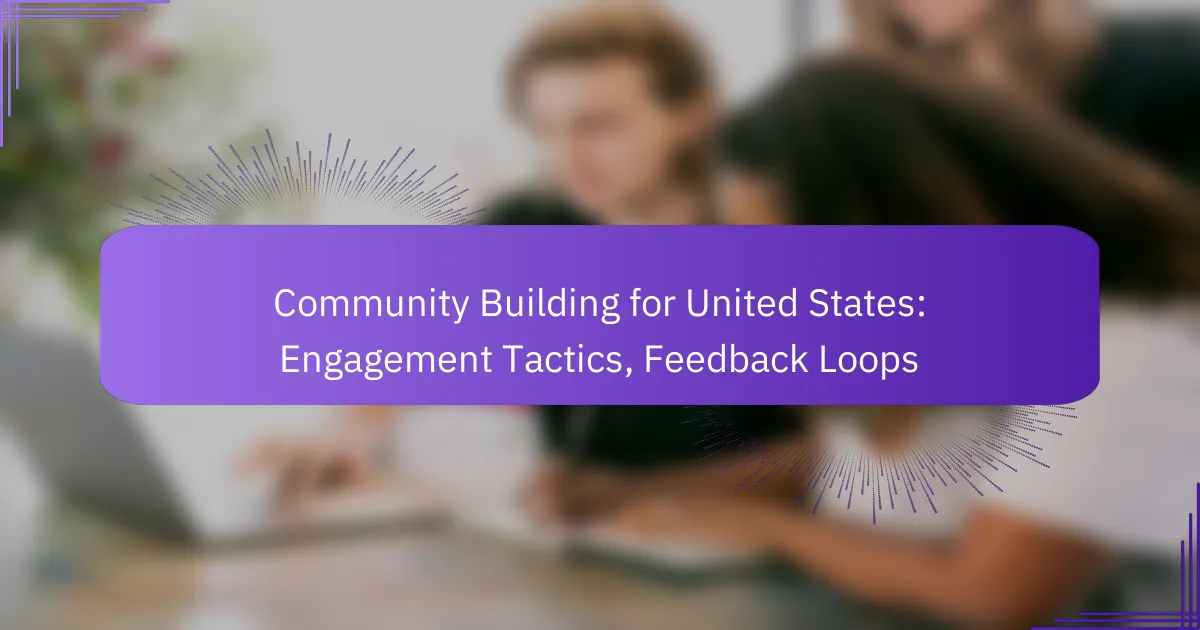Building a strong community in the United States requires effective engagement tactics that harness the power of social media, valuable content, and collaborative projects. By implementing feedback loops, organizations can create a responsive environment where members feel valued and connected. Utilizing digital tools further enhances interaction and fosters a sense of belonging among community members.
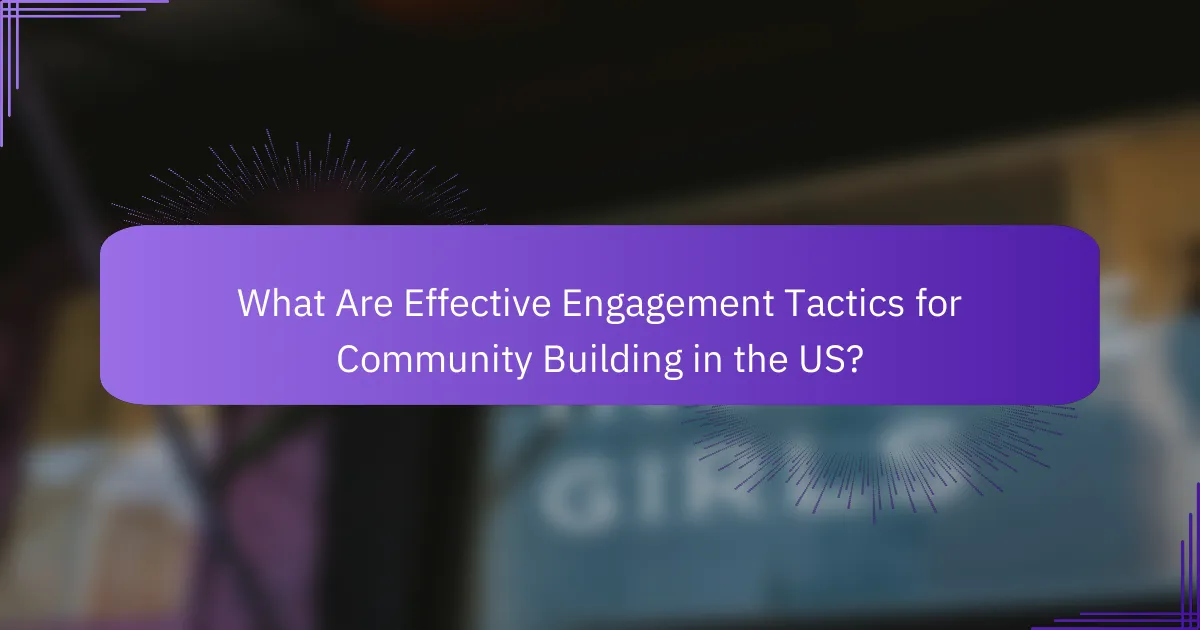
What Are Effective Engagement Tactics for Community Building in the US?
Effective engagement tactics for community building in the US include leveraging social media, creating valuable content, hosting virtual events, collaborating on projects, and forming partnerships with influencers. These strategies foster connection, encourage participation, and enhance the overall community experience.
Social Media Campaigns
Social media campaigns are a powerful way to engage community members by sharing relevant content and encouraging interaction. Platforms like Facebook, Instagram, and Twitter allow for targeted messaging, enabling you to reach specific demographics effectively.
When planning a campaign, consider using polls, contests, or user-generated content to boost participation. Aim for a consistent posting schedule and engage with comments to foster a sense of community.
Content Creation Strategies
Creating valuable content is essential for keeping community members informed and engaged. This can include blog posts, newsletters, videos, or podcasts that address community interests and concerns.
Focus on quality over quantity; a few well-researched pieces can be more impactful than frequent, less thoughtful content. Encourage feedback on your content to understand what resonates with your audience.
Virtual Events and Webinars
Virtual events and webinars provide an interactive platform for community members to connect and learn. These events can cover topics of interest, showcase local experts, or facilitate discussions on relevant issues.
To maximize attendance, promote events through social media and email newsletters. Consider recording sessions for those who cannot attend live, and follow up with participants to gather feedback and suggestions for future events.
Collaborative Projects
Collaborative projects encourage community members to work together towards a common goal, fostering a sense of ownership and belonging. These can range from community clean-up days to joint fundraising efforts for local charities.
Clearly define roles and responsibilities to ensure everyone feels included and valued. Highlight the outcomes of these projects to showcase the community’s impact and motivate further participation.
Influencer Partnerships
Partnering with influencers can amplify your community-building efforts by reaching wider audiences. Influencers can help promote events, share content, and encourage their followers to engage with your community.
Choose influencers whose values align with your community’s mission. Collaborate on campaigns that feel authentic and provide mutual benefits, such as increased visibility and engagement for both parties.
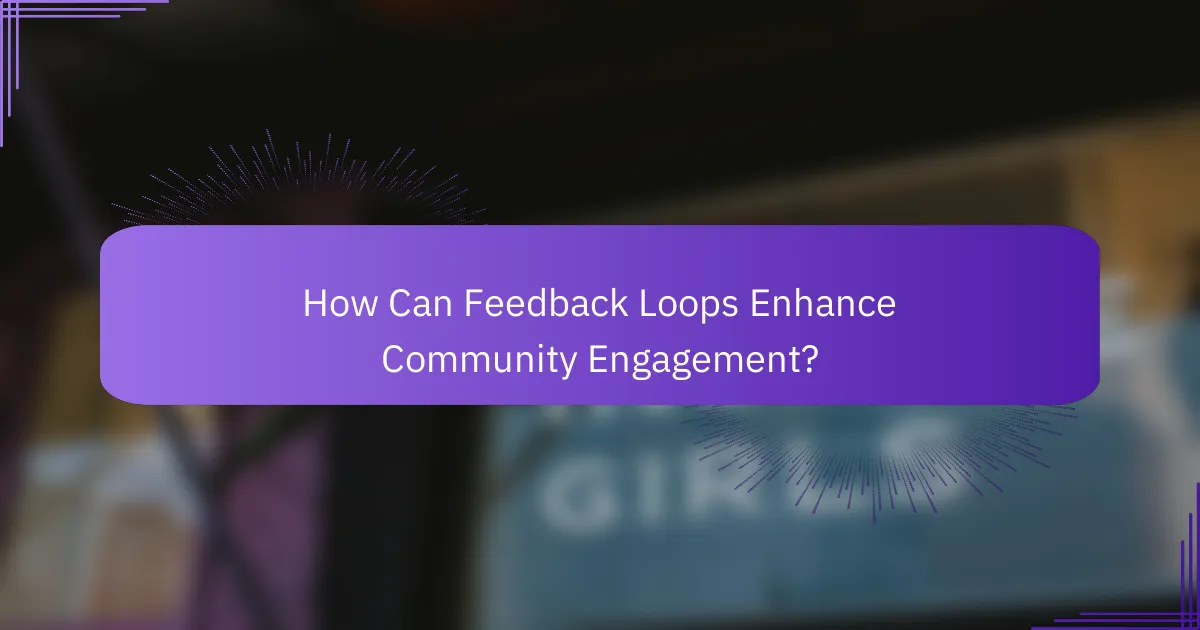
How Can Feedback Loops Enhance Community Engagement?
Feedback loops are essential for enhancing community engagement as they create a continuous cycle of input and response. By actively seeking and incorporating community feedback, organizations can foster a sense of belonging and ensure that members feel valued and heard.
Surveys and Polls
Surveys and polls are effective tools for gathering quantitative data from community members. They can be distributed through email, social media, or community platforms, allowing for quick responses. Aim for a mix of multiple-choice questions and open-ended responses to capture both specific data and personal insights.
Consider keeping surveys brief, ideally under 10 questions, to encourage participation. Offering incentives, such as gift cards or recognition, can also boost response rates. Regularly conducting surveys helps track changes in community sentiment over time.
Focus Groups
Focus groups involve small, diverse groups of community members discussing specific topics in depth. This qualitative method allows for richer insights and nuanced feedback that surveys may miss. Organize sessions with 6-10 participants to facilitate open dialogue and ensure everyone has a chance to contribute.
Prepare guiding questions in advance but remain flexible to explore emerging themes. Recording sessions (with permission) can help capture detailed feedback. Be mindful of group dynamics; ensure that dominant voices do not overshadow quieter participants.
Community Forums
Community forums provide a platform for ongoing discussions and feedback among members. These can be hosted on dedicated websites or social media groups, allowing for real-time interaction. Encourage members to share ideas, ask questions, and provide feedback on community initiatives.
To maintain engagement, establish clear guidelines for respectful communication and regular moderation. Highlight popular topics or questions to keep discussions relevant. Consider summarizing key takeaways from forum discussions to share with the broader community, reinforcing the value of member contributions.
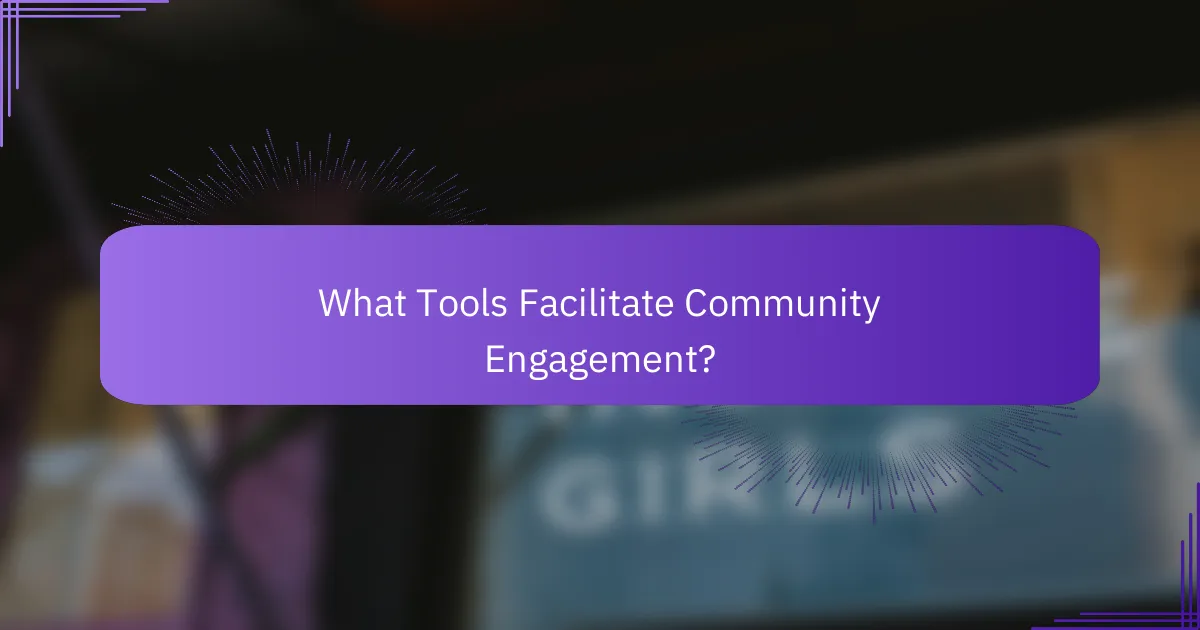
What Tools Facilitate Community Engagement?
Effective community engagement in the United States often relies on a variety of digital tools designed to foster interaction and collaboration. These tools enable real-time communication, facilitate teamwork, and create spaces for community members to connect and share ideas.
Discord for Real-Time Communication
Discord is a popular platform for real-time communication, particularly among gaming and tech communities. It allows users to create servers where members can join voice channels, text chats, and share multimedia content instantly.
To leverage Discord effectively, consider setting up dedicated channels for specific topics or events. This organization helps keep discussions focused and encourages participation. Regularly scheduled voice chats or community events can further enhance engagement.
Slack for Team Collaboration
Slack is primarily used for team collaboration in professional settings but can also serve community groups. It offers channels for different projects, direct messaging, and integration with various productivity tools, making it easy to share information and updates.
When using Slack for community engagement, create channels that reflect the interests of your members. Encourage the use of threads to keep conversations organized and avoid clutter. Regular check-ins or feedback sessions can help maintain momentum and foster a sense of belonging.
Facebook Groups for Community Interaction
Facebook Groups provide a familiar space for community interaction, allowing members to share posts, photos, and events. This platform is beneficial for reaching a broad audience, especially those already active on Facebook.
To maximize engagement in Facebook Groups, post regularly and encourage members to share their experiences and insights. Use polls and questions to solicit feedback and spark discussions. Keep in mind that group moderation is essential to maintain a positive environment and ensure that all voices are heard.
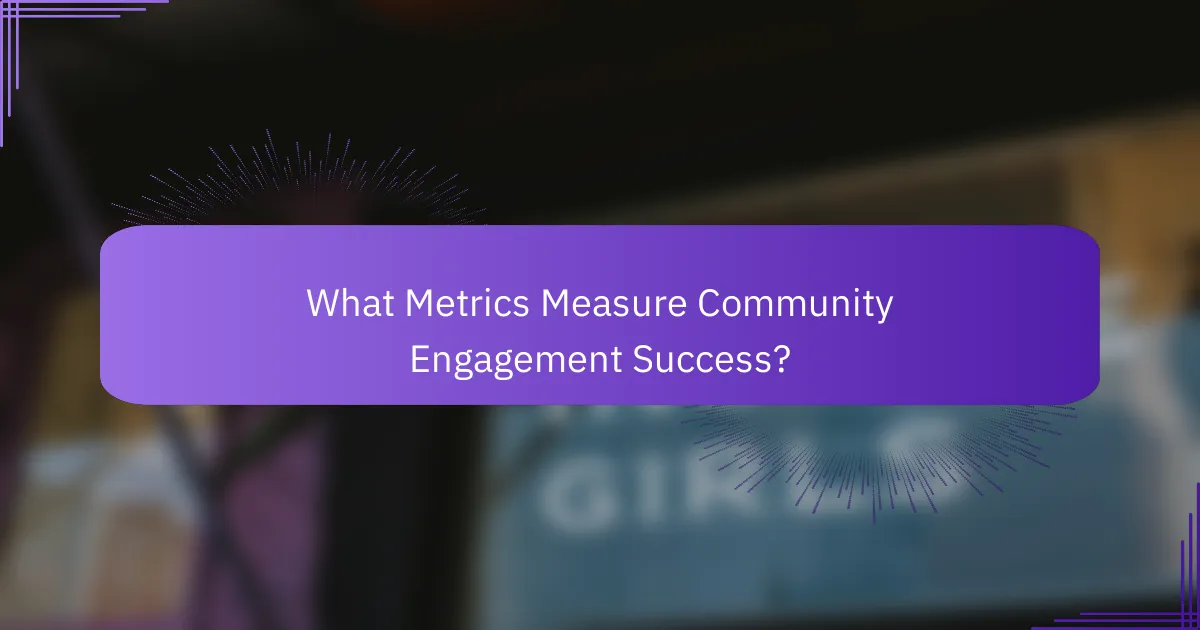
What Metrics Measure Community Engagement Success?
Key metrics for measuring community engagement success include active participation rates, content interaction levels, and feedback response rates. These metrics provide insights into how engaged community members are and how effectively they are contributing to the community.
Active Participation Rates
Active participation rates indicate the percentage of community members who engage regularly with community activities, such as forums, events, or discussions. A healthy participation rate typically falls between 20% to 50% of your total members, depending on the community size and type.
To improve participation, consider implementing incentives like recognition programs or exclusive content for active members. Avoid overwhelming members with too many activities, as this can lead to disengagement.
Content Interaction Levels
Content interaction levels measure how often community members engage with shared content, such as posts, articles, or videos. This can include likes, shares, comments, and views, with effective engagement often seen in the range of 5% to 15% of total views translating into interactions.
To boost interaction, create compelling and relevant content that resonates with your audience. Regularly analyze which types of content generate the most engagement and adjust your strategy accordingly.
Feedback Response Rates
Feedback response rates reflect how many community members provide feedback on initiatives, surveys, or discussions. A good response rate is typically around 10% to 30%, depending on the method of outreach and the community’s size.
To enhance feedback rates, ensure that surveys are concise and easy to complete. Follow up with reminders and communicate how feedback will be used to improve the community, fostering a sense of ownership among members.
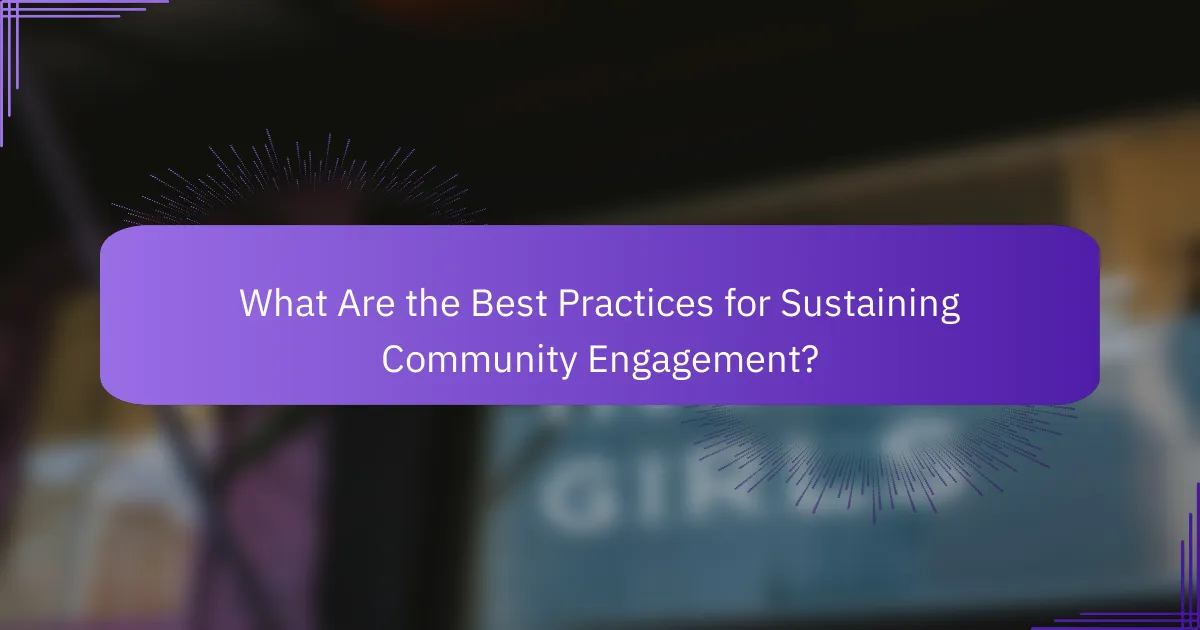
What Are the Best Practices for Sustaining Community Engagement?
Sustaining community engagement involves consistent interaction, valuable content, and responsive feedback mechanisms. By implementing effective strategies, communities can foster a vibrant environment that encourages participation and loyalty.
Regular Content Updates
Regular content updates are crucial for maintaining community interest and involvement. Fresh and relevant information keeps members informed and engaged, making them more likely to participate in discussions and activities.
Consider a schedule for updates, such as weekly newsletters or monthly webinars. This consistency helps set expectations and encourages members to return for new content. Use a mix of formats, including articles, videos, and infographics, to cater to different preferences.
To maximize impact, focus on topics that resonate with your community’s interests. Solicit feedback on what members want to see more of, and adjust your content strategy accordingly. Avoid overwhelming your audience with too much information at once; instead, prioritize quality over quantity.
